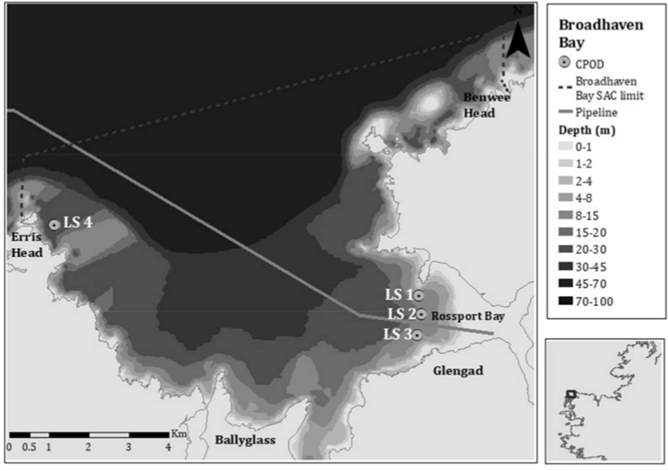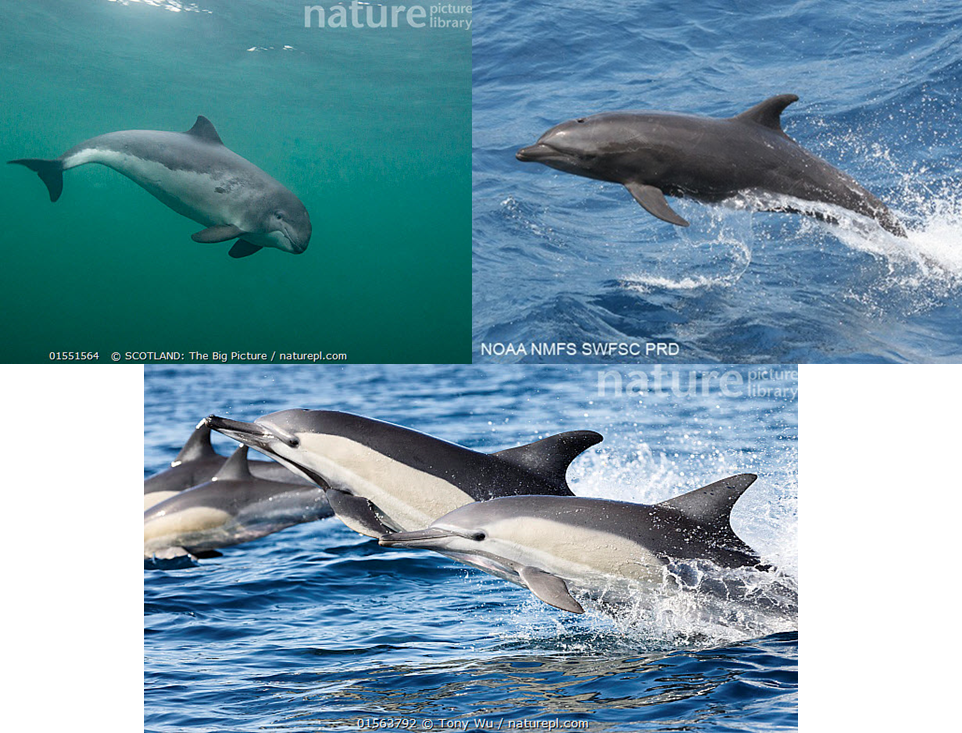Eavesdropping on Cetaceans: Using Passive Acoustic Monitoring to Investigate Cetacean Distribution in North-west Ireland.
Cetaceans such as dolphins and porpoises are highly vulnerable to anthropogenic activities. Disturbance, displacement, morbidity, and mortality in cetaceans often results from prey being overfished, being bycaught themselves, boat collisions, and habitat degradation (i.e. noise and chemical pollution, mechanical damage).
Due to these threats and the conservation status of most marine megafauna, European law dictates cetacean populations must be protected and maintained, ultimately minimising disturbance in proximity to sites associated with crucial activities (i.e. feeding, breeding, and resting). Protective measures vary, ranging from the generation of marine protected areas or restricting activities such as fishing, construction, and recreational boating to certain locations and times. However, deciding which measures to implement is largely dictated by our understanding of the temporal patterns in the target species’ distribution and habitat usage within a given area.
This is particularly problematic for cetaceans, which are typically identified, located, and tracked across extensive ranges via boat, making effective monitoring difficult and expensive. Whilst these visual surveys can provide valuable information regarding abundance and distribution, they are time consuming and restricted to preferable weather and light conditions. Furthermore, cryptic species (i.e. harbour porpoise Phocoena phocoena ) are often missed due to visual detection rates declining dramatically during conditions greater than Beaufort sea state 2 (light breeze, 4-6kt wind speeds, 0.2-0.5m waves with small wavelets, glossy unbreaking crests). As such, our current understanding of space usage in mobile marine cetaceans is hindered by being predominantly derived from short-term, visual data lacking environmental variability.
Despite these limitations, current knowledge of cetacean behaviour identifies that their distribution patterns likely result from being predominantly apex predators foraging for patchy prey resources, differing seasonally and inter-annually alongside a range of environmental proxies for prey distribution and abundance.
Whilst data gaps persist, Irish waters are recognised as one of the most significant areas for cetaceans in Europe. Nine species of cetacean are sighted in Broadhaven Bay alone, largely due to the variety of habitats present (i.e large shallow inlets and bays, mud and sandflats, reefs, tidal inlets, estuaries). As such, in 2001 Broadhaven became the site of the longest marine mammal monitoring programme of its kind in Ireland (figure 1), where Todd et al. (2020) set about filling in some of these data gaps. Longitudinal Passive Acoustic Monitoring (PAM) data was collected between 2009 and 2017 to investigate year-round seasonal and temporal patterns, as well as environmental influences, upon the distribution of the harbour porpoise ( P. phocoena ) and local dolphin species (bottlenose dolphins Tursiops truncates, common dolphin Delphinus delphis ).
P. phocoena , T. truncates and D. delphis (figure 2) are prime candidates for studying temporal and environmental patterns in Irish cetacean distribution, due to their prevalence and known variations in life history and habitat usage. For example, P. phoecoena is known to be an important, frequently observed, indicator species and top predator across habitats, with a wide distribution likely influenced by prey availability due to their small body size and high energetic demands. Similarly, T. truncatus populations are found within a variety of habitats, and although some exploit deeper offshore waters the species typically maintains an inshore distribution. D. delphis on the other hand occurs seasonally across inshore and offshore waters at depths of up to 200m, seemingly moving further offshore during summer to reduce potential competition with other inshore habitat users.
As PAM functions by detecting the acoustic signals generated during navigation and foraging (echolocation) in odontocetes, it is far more cost effective than visual surveys and facilitates continuous monitoring irrespective of time and weather. As such, Todd deployed fixed Cetacean-Porpoise Detectors (CPOD’s) year-round, detecting cetacean clicks between 20 – 160k kHz at a maximum range of 400m for harbour porpoises and 1km for delphinids - subject to conditions, ambient noise, and cetacean orientation. 3 COPD’s were situated 500m apart within the inner bay, at an average high-tide depth of 17m, whilst 1 was located in the tidally active waters of the outer bay at a depth of 34m. Environmental data such as tide and sunset were obtained from Ballyglass, Killybegs and Belmullet, whilst 430 days’ worth of construction activity records between 2009 and 2015 were sourced from the Department of Communications, Climate Action and the Environment, denoting the presence or absence of such disturbance. It must be noted that delphinid species cannot yet be differentiated between using COPD data alone due to click similarities, so clicks were identified visually and utilising software in order to determine detection positive minutes (DPM) and the hours (DPH) in which at least one positive detection was recorded.
Whilst Broadhaven may only represent a fraction of Irish cetacean distributive ranges, 168,091 hours of acoustic data was collected. 21,836 and 32,635 DPH of which were attributed to harbour porpoises and delphinids respectively, primarily within the deeper, outer region of the bay near an area of tidal upwelling and a strong current. Although cetacean movements in and out of the area may warrant further study, as it is difficult and unethical to confine dolphins and porpoises to the bay in order to protect them, the data still has provided significant insight. In a first for reported literature, whilst both were detected year-round, porpoises and common dolphins expressed a strong, repeating, bi-annual peak. When coupled with the seasonal data acquired, this meant that both appeared most frequently during winter every other year. However, whilst porpoise distribution did not appear to be influenced by the time of day, dolphins were most likely to be detected at dawn. It is possible that dolphins are driving the observed seasonal variations and species segregation through factors such as aggressive competition. However, the data also supports previous studies indicating that dietary overlap and foraging behaviour, alongside factors such as prey abundance, distribution, habitat preference and activity, are largely influential. Finally, whilst the impacts of percussive and continuous noise could not be investigated, construction detrimentally affected porpoises whilst seemingly having minimal impacts of delphinids. This was shown by activities such as seismic surveys, pipe laying and dredging temporarily resulting in up to 90% reductions in porpoise detection.
Overall, Todd highlighted the importance acoustic monitoring in relation to the long-term, regional studies required to understand cetacean distributions and the associated influential factors. The findings suggest that it may be best to continue to protect and somewhat restrict anthropogenic activities away from key areas, or to off peak seasons and years. Such information could be utilised to better inform mitigation in Ireland and around the world, in order to minimise disturbance and conserve these much beloved species.
Reference:
Todd, N.R.E., Cronin, M., Luck, C., Bennison, A., Jessop, M., and Kavanagh, A.S. (2020). Using passive acoustic monitoring to investigate the occurrence of cetaceans in a protected marine area in northwest Ireland. Estuarine, Coastal and Shelf Science. 232: 2 – 8.
SHARE THIS ARTICLE















